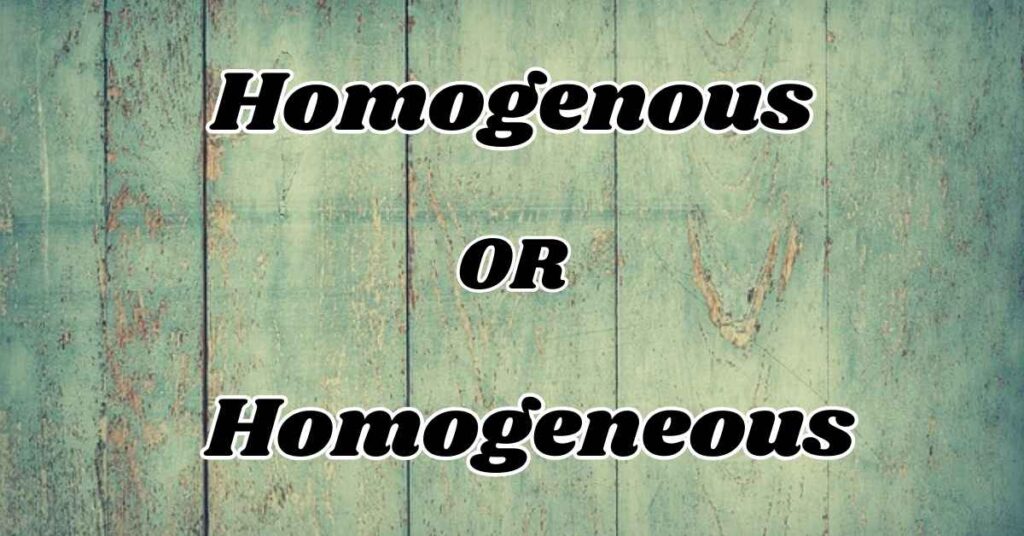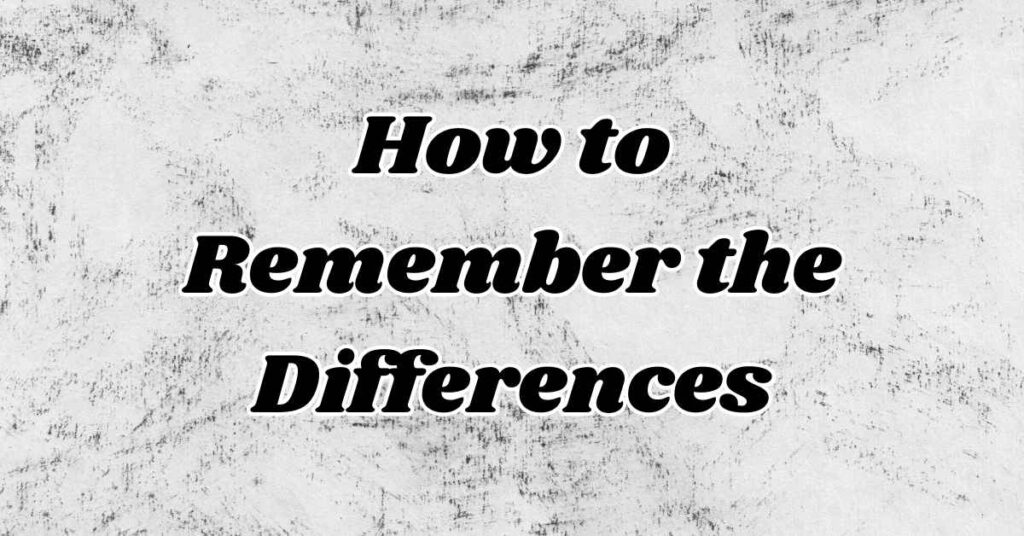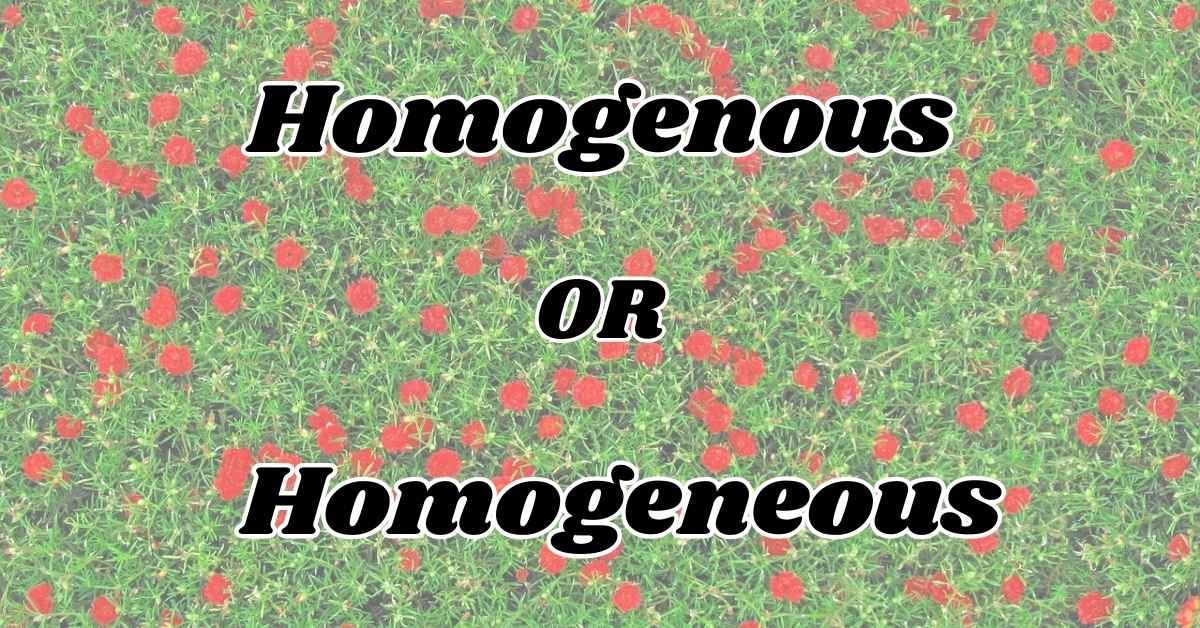Homogenous or Homogeneous can often confuse writers and speakers alike. While both terms refer to uniformity and similarity, their usage differs significantly. Understanding the distinction between these two words is crucial for clear communication, especially in academic and scientific contexts.
“Homogeneous” is the preferred term in modern English, particularly in fields like biology and chemistry, where it describes mixtures or groups that are consistent throughout.
On the other hand, “homogenous” is less common and often considered outdated. In this article, we will explore the meanings, origins, and proper usages of homogenous vs homogeneous, helping you navigate this linguistic challenge with confidence.
Quick Summary
“Homogeneous” is the correct spelling for most uses today, especially in scientific contexts. “Homogenous,” while still found in some texts, is less common and often considered outdated. Understanding this distinction is essential for effective communication, especially in academic and professional settings.
Understanding Homogenous or Homogeneous

Both terms refer to a state of uniformity or similarity. When we say something is homogeneous, we mean that it has a consistent composition or nature throughout. For example, a homogeneous mixture in chemistry has the same composition in every part of the mixture.
On the other hand, “homogenous” is often used incorrectly when people mean “homogeneous.” This confusion arises because both words sound similar and appear to have overlapping meanings.
Origins of the Homogeneous
The word homogeneous emerged in the 1640s from Medieval Latin “homogeneus,” which traces back to the Greek “homogenes,” meaning “of the same kind.” This Greek term combines “homos,” meaning “same,” and “genos,” meaning “kind” or “race.”
An earlier form, “homogeneal,” appeared around 1600. Related terms include “homogeneously” and “homogeneousness,” highlighting its consistent usage in language.
Homogenous: Definition and Usage

Homogenous refers to a state of uniformity where all components are similar or identical. It is often used in contexts where consistency is key, such as in discussions about groups or materials.
Although “homogenous” was once more widely accepted, its usage has declined in favor of “homogeneous,” especially in scientific and academic writing. Understanding this definition helps clarify when and how to use the term appropriately.
Homogenous Meanings
The meanings associated with homogenous typically revolve around similarity and uniformity. For example, it can describe a group of people with shared characteristics or a mixture where all parts are alike.
In psychology, a homogenous group might exhibit similar opinions or behaviors, which can lead to phenomena like groupthink, where diverse perspectives are overlooked.
Homogenous Usage
The usage of homogenous has become less common. Many speakers may mistakenly use it instead of “homogeneous.” However, it still appears in specific contexts, particularly when discussing older scientific texts or particular fields.
Misunderstandings can arise from this outdated usage, making it essential to recognize the distinction for clearer communication.
Synonyms of Homogenous
Here are synonyms you might consider when discussing concepts related to homogeneity:
- Uniform
- Similar
- Consistent
- Alike
- Identical
- Unvaried
- Standardized
- Monolithic
- Unchanging
- Equal
These synonyms can help clarify your writing when discussing similar ideas.
Homogeneous: Definition and Usage

In contrast, “homogeneous” is defined as having parts that are all of the same kind or nature. This term is widely used across various fields, including science, sociology, and everyday conversation.
For example, a homogeneous mixture in chemistry means that every sample taken from it will have the same properties.
Homogeneous Meanings
The meanings associated with “homogeneous” extend beyond just physical mixtures. In social contexts, a homogeneous society might refer to a community where most people share similar cultural backgrounds or beliefs. This concept can also be applied to discussions about diversity and inclusion.
Homogeneous Usage
The usage of “homogeneous” is prevalent in both academic and casual conversations today. It appears frequently in scientific literature when discussing topics like complex fluids or biological studies involving population genetics. Understanding how to use this term correctly enhances clarity in communication.
Side by Side Comparison
To better understand these terms’ differences and similarities, here’s a comparison:
| Aspect | Homogenous | Homogeneous |
| Definition | Older term; less common usage | Commonly used; clear meaning |
| Origin | Scientific; now obsolete | Greek roots; widely accepted |
| Usage | Limited contexts | Broad application |
This table highlights how both terms relate but also their distinct paths in modern usage.
Everyday Usage Examples

Homogenous vs homogeneous often comes up in discussions about groups or mixtures. For instance, you might say a team is homogeneous if all members share similar backgrounds or opinions.
Similarly, in cooking, a homogeneous mixture refers to ingredients that blend seamlessly, like a smoothie. Understanding how to use these terms correctly helps clarify your communication and ensures your message is easily understood by others.
Homogenous Examples in a Sentence
- The homogenous group shared similar interests.
- The research team was homogenous in the background.
- The fabric had a homogenous texture throughout.
- His opinions seemed homogenous to those around him.
- The town’s culture felt homogenous to outsiders.
Homogeneous Examples in a Sentence
- The homogeneous mixture blended seamlessly.
- The audience was homogeneous, reflecting similar demographics.
- The lake’s surface appeared homogeneous under the moonlight.
- In chemistry, a homogeneous solution is crucial for experiments.
- The classroom was homogeneous, with students from similar backgrounds.
These examples illustrate how each term can be used effectively within different contexts.
How to Remember the Differences

To keep these terms straight, remember that “homogeneous” refers to uniformity and consistency across various fields like science and sociology while “homogenous” is less commonly used today and often relates to older texts or specific contexts where it still applies.
More Article: Proscribed vs Prescribed: What’s the Difference?
FAQS: Homogenous or Homogeneous
Does homogeneous have two pronunciations?
Yes, “homogeneous” can be pronounced as either /ˌhɒməˈdʒiːnəs/ or /ˌhoʊməˈdʒiːnəs/, both are accepted.
Is it homogenous or heterogenous?
The correct term is “homogeneous,” while “heterogeneous” refers to a mixture with different components.
Are homogenous and homogeneous the same word?
No, “homogenous” is often considered outdated, while “homogeneous” is the preferred term in modern usage.
Why do people say homogenous?
People may say “homogenous” due to confusion or habit, often using it incorrectly when they mean “homogeneous.”
Conclusion
Homogenous or Homogeneous may seem similar, but understanding their differences is essential for effective communication. While “homogeneous” is the correct and widely accepted term used in scientific and academic contexts, “homogenous” has become largely obsolete.
By using “homogeneous” correctly, you can enhance clarity in your writing and discussions, particularly in fields like biology and sociology. Remembering this distinction will not only improve your vocabulary but also ensure that your ideas are conveyed accurately to your audience. Embrace this knowledge to communicate with confidence.
Related Post: Togather or Together: What’s the Difference?

